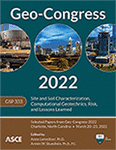Consideration of One Camera Photogrammetry-Based Method to Reevaluate Some Aspects of Conventional Triaxial Testing
Publication: Geo-Congress 2022
ABSTRACT
Triaxial tests have been extensively used in geotechnical engineering to determine soil characteristics and investigate soil behavior. However, little research has been carried to evaluate important aspects of common triaxial testing that can cause misleading interpretation of soil properties. The key reason for this is the absence of a proper and affordable method to monitor the actual soil behavior during various steps of triaxial testing. Recently, a photogrammetry-based method was proposed and proved highly accurate measurements of local, total, and absolute volumes, specimen deformations, and strain localization. This paper suggests a practical re-evaluation of some aspects and practices in the conventional triaxial testing by applying the advancement of the photogrammetry-based technique. The analysis of a series of drained triaxial compression tests using the photogrammetry-based method proved the ability to determine the tilting, the misalignment, and the likelihood of leakage during saturation of soil specimen, and the preparatory, consolidation, and shearing stages of triaxial testing. The experimental results presented relevant insights about the major errors during laboratory procedures and testing including the deviation of the effective stress path, maximum shear stress, axial strain, stress–strain relationship, and soil strength. The measurement of the eccentricity and tilting angle of soil specimen provided proof of potential errors and are recommended to be considered to evaluate the reliability of soil characteristics measurement during triaxial testing. In addition to that, the procedure presented in this paper reinforces the importance of the adoption of the photogrammetry-based method to accurately determine the soil properties during triaxial testing.
Get full access to this article
View all available purchase options and get full access to this chapter.
REFERENCES
ASTM Standard D7181. (2011). Standard test method for consolidated drained triaxial compression test for soils. ASTM International, West Conshohocken, PA, www.astm.org.
Baldi, G., Hight, D. W., and Thomas, G. E. (1988). “State-of-the-art paper: a reevaluation of conventional triaxial test methods.” In Advanced triaxial testing of soil and rock. ASTM International.
Riad, B., and Zhang, X. (2021). “Consistent Three-Dimensional Elasto-Plastic Model to Study Unsaturated Soil Behavior with Considerations of Coupled Hydro-Mechanical Hysteresis.” Transportation Research Record, 03611981211002217.
Fayek, S., Xia, X., and Zhang, X. (2020a). “A Least Square Optimization Approach for Determining the Soil Boundary and Absolute Volume of Unsaturated Soils”. In Geo-Congress 2020: Geo-Systems, Sustainability, Geoenvironmental Engineering, and Unsaturated Soil Mechanics, ASCE, Reston, VA, 394–401.
Fayek, S., Xia, X., Li, L., and Zhang, X. (2020b). “Photogrammetry-Based Method to Determine the Absolute Volume of Soil Specimen during Triaxial Testing.” Transportation Research Record, 2674(8), 206–218.
Fayek, S., Xia, X., and Zhang, X. (2022a). “Validation of Photogrammetry-Based Method to Determine the Absolute Volume of Unsaturated Soils.” In Advances in Transportation Geotechnics IV (pp. 773–781). Springer, Cham.
Fayek, S., Zhang, X., and Galinmoghadam, J. (2022b). “Point Density for Triaxial Specimen Volume Measurements in Image-based Methods.” Geotechnical Testing Journal (Under Review).
Fayek, S., Xia, X., Li, L., and Zhang, X. (2022c). “Evaluating the Effects of Specimen Misalignment during Triaxial Testing Using a Photogrammetry-based Method.” Transportation Research Record (Under Review).
Germaine, J. T., and Ladd, C. C. (1988). “State-of-the-art paper: Triaxial testing of saturated cohesive soils.” In Advanced triaxial testing of soil and rock. ASTM International.
Hossain, D. (1995). “Leakage control in long-duration testing of triaxial specimens.” Journal of geotechnical engineering, 121(11), 810–813.
Karademir, T. (2013). “Computer-Automated Triaxial Testing System for Assessing and Mitigating Sample Disturbance in a Natural Clay in the Laboratory”. Journal of Testing and Evaluation, 42(1), 78–92.
Karlsson, M., Emdal, A., and Dijkstra, J. (2016). “Consequences of sample disturbance when predicting long-term settlements in soft clay.” Canadian Geotechnical Journal, 53(12), 1965–1977.
Lade, P. V. (2016). Triaxial testing of soils. John Wiley & Sons.
Leroueil, S., Tavenas, F., La Rochelle, P., and Tremblay, M. (1988). “Influence of filter paper and leakage on triaxial testing.” In Advanced triaxial testing of soil and rock. ASTM International.
Lim, G. T., Pineda, J., Boukpeti, N., Carraro, J. A. H., and Fourie, A. (2019). “Effects of sampling disturbance in geotechnical design.” Canadian Geotechnical Journal, 56(2), 275–289.
Lunne, T., Berre, T., Andersen, K. H., Strandvik, S., and Sjursen, M. (2006). “Effects of sample disturbance and consolidation procedures on measured shear strength of soft marine Norwegian clays.” Canadian Geotechnical Journal, 43(7), 726–750.
Mikhail, E. M., Bethel, J. S., and McGlone, J. C. (2001). Introduction to modern photogrammetry. Wiley, New York. ISBN:0-471-30924-9.
Poulos, S. J. (1964). Control of leakage in the triaxial test., Harvard University. p.230.
Rowe, P. W., and Barden, L. (1964). “Importance of free ends in triaxial testing.” Journal of the Soil Mechanics and Foundations Division, 90(1), 1–27.
Scholey, G. K., Frost, J. D., Presti, D. L., and Jamiolkowski, M. (1995). “A review of instrumentation for measuring small strains during triaxial testing of soil specimens.” Geotechnical Testing Journal, 18(2), 137–156.
Zhang, X., Li, L., Chen, G., and Lytton, R. (2015). “A photogrammetry-based method to measure total and local volume changes of unsaturated soils during triaxial testing.” Acta Geotechnica. 10(1), 55–82.
Information & Authors
Information
Published In
History
Published online: Mar 17, 2022
Authors
Metrics & Citations
Metrics
Citations
Download citation
If you have the appropriate software installed, you can download article citation data to the citation manager of your choice. Simply select your manager software from the list below and click Download.
Cited by
- Sara Fayek, Xiong Zhang, Xiaolong Xia, Qingqing Fu, Jeffrey Cawlfield, Measurement of Volumetric Deformation, Strain Localization, and Shear Band Characterization during Triaxial Testing Using a Photogrammetry-Based Method, Geo-Congress 2023, 10.1061/9780784484678.047, (466-476), (2023).
